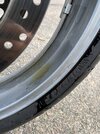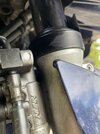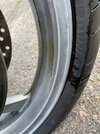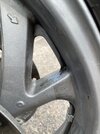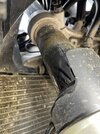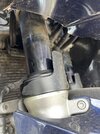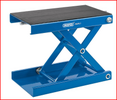I am looking for help figuring out what needs repaired on my bike. Please see the pics. I posted this situation on the FB groups, but I only got snarky remarks.
I did not have many opportunities to ride last year. One day last fall, I got all set up for a long ride and found what can be seen in the pics. Basically, there was a oil-like substance pooled up on the wheel. The bike had probably sat for 2 months at this point. At first, I thought it might be brake fluid. But, then I noticed the forks looked a bit wet.
It got me thinking that it might be the fork seals. But, I can't imagine how this would have happened. The only thing that I could think of was that I transported the bike a few months before that. Is it possible that I tightened the straps too tight while on the trailer and then hit a bump, causing the fork seals to blow out? The problem with this theory is that I rode the bike at least once or twice after that and it seemed completely fine. Nothing happened on those rides that would have caused this.
Am I looking at replacing fork seals here? What else could it be? If it is the fork seals, is there a good online video tutorial that you know of? I found a video on Youtube, but it's an hour long and makes the job seem like a royal PITA.
Thoughts?
I did not have many opportunities to ride last year. One day last fall, I got all set up for a long ride and found what can be seen in the pics. Basically, there was a oil-like substance pooled up on the wheel. The bike had probably sat for 2 months at this point. At first, I thought it might be brake fluid. But, then I noticed the forks looked a bit wet.
It got me thinking that it might be the fork seals. But, I can't imagine how this would have happened. The only thing that I could think of was that I transported the bike a few months before that. Is it possible that I tightened the straps too tight while on the trailer and then hit a bump, causing the fork seals to blow out? The problem with this theory is that I rode the bike at least once or twice after that and it seemed completely fine. Nothing happened on those rides that would have caused this.
Am I looking at replacing fork seals here? What else could it be? If it is the fork seals, is there a good online video tutorial that you know of? I found a video on Youtube, but it's an hour long and makes the job seem like a royal PITA.
Thoughts?

